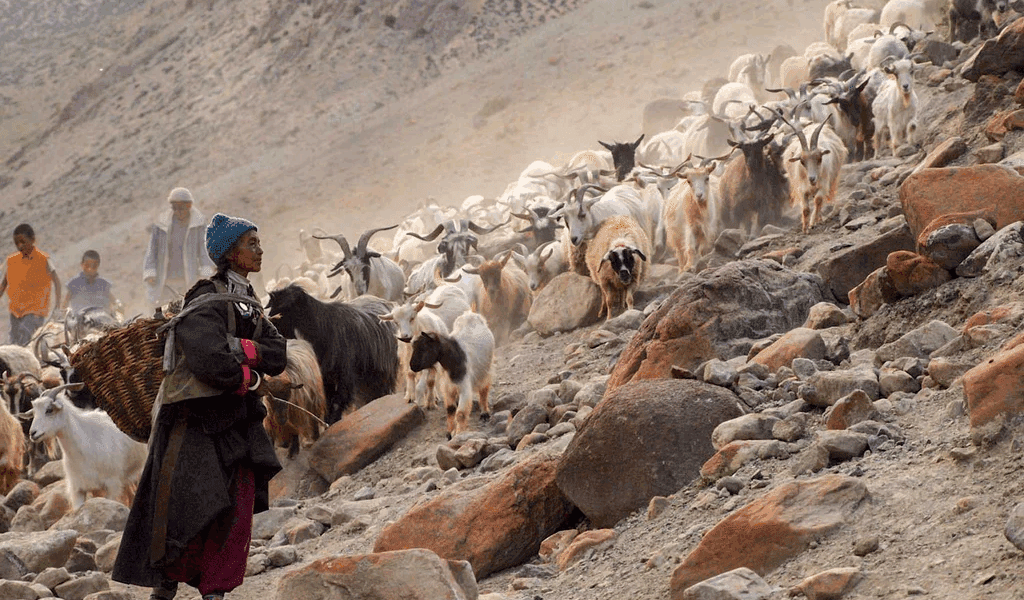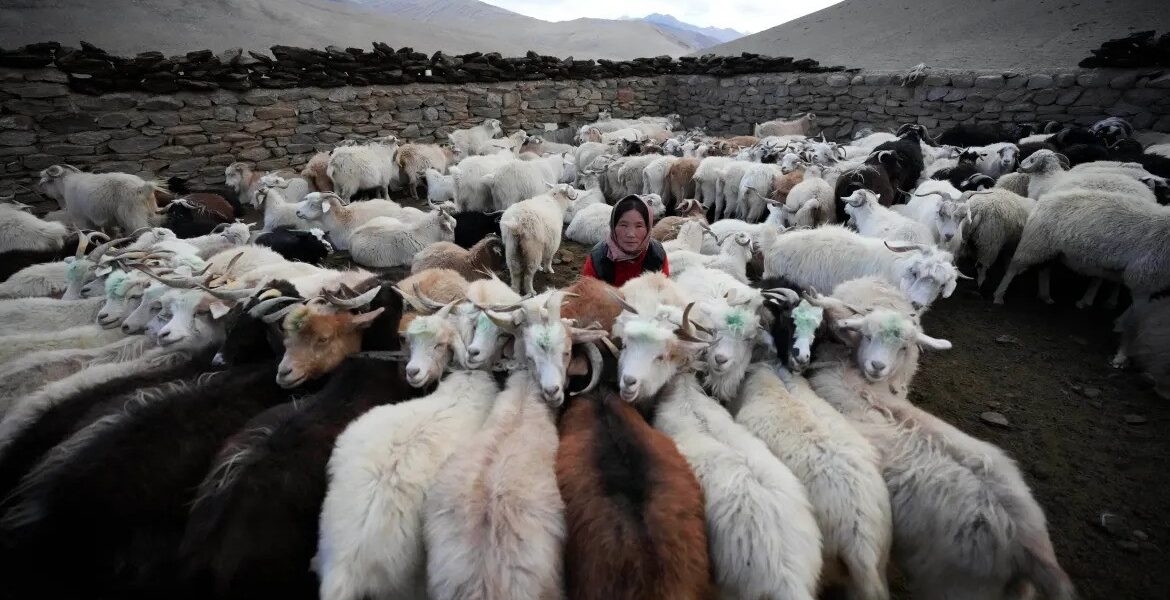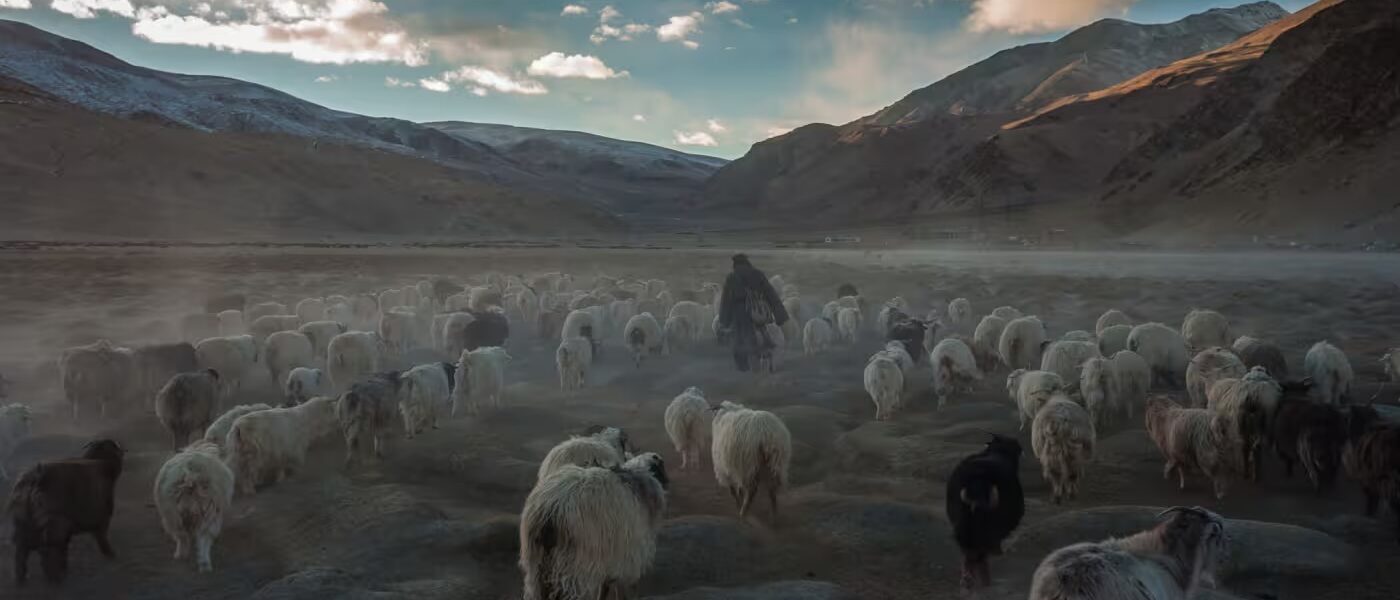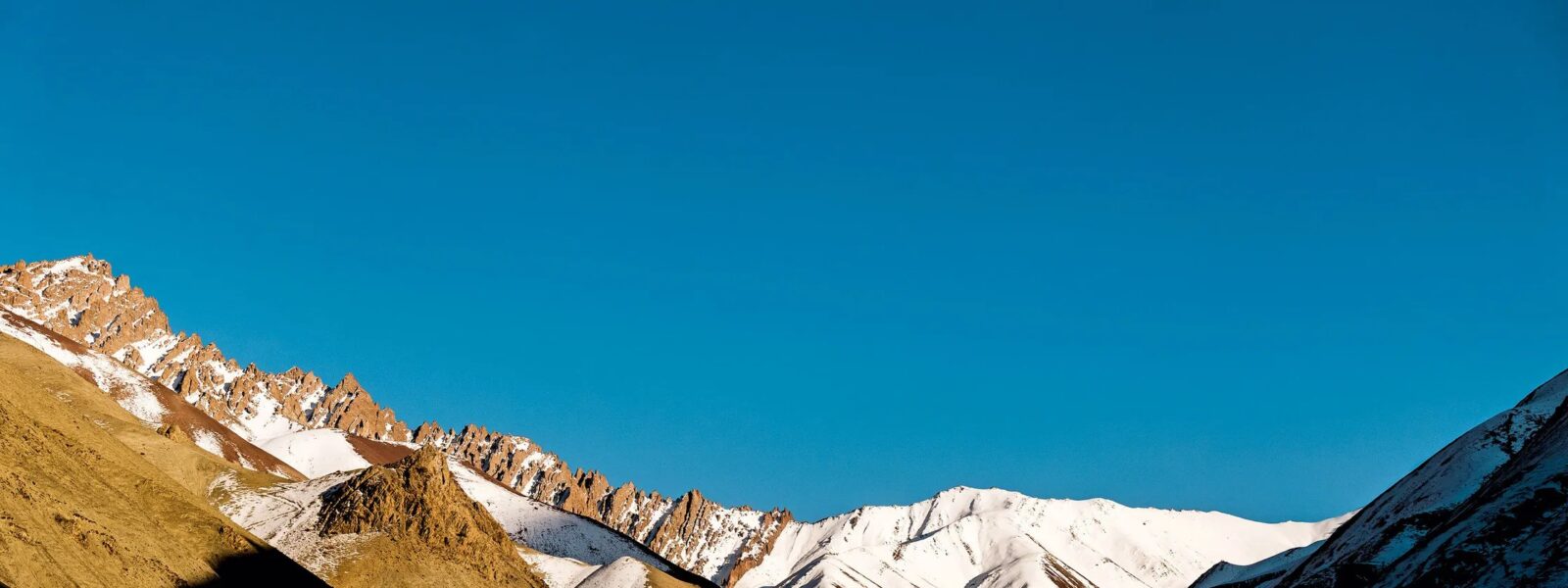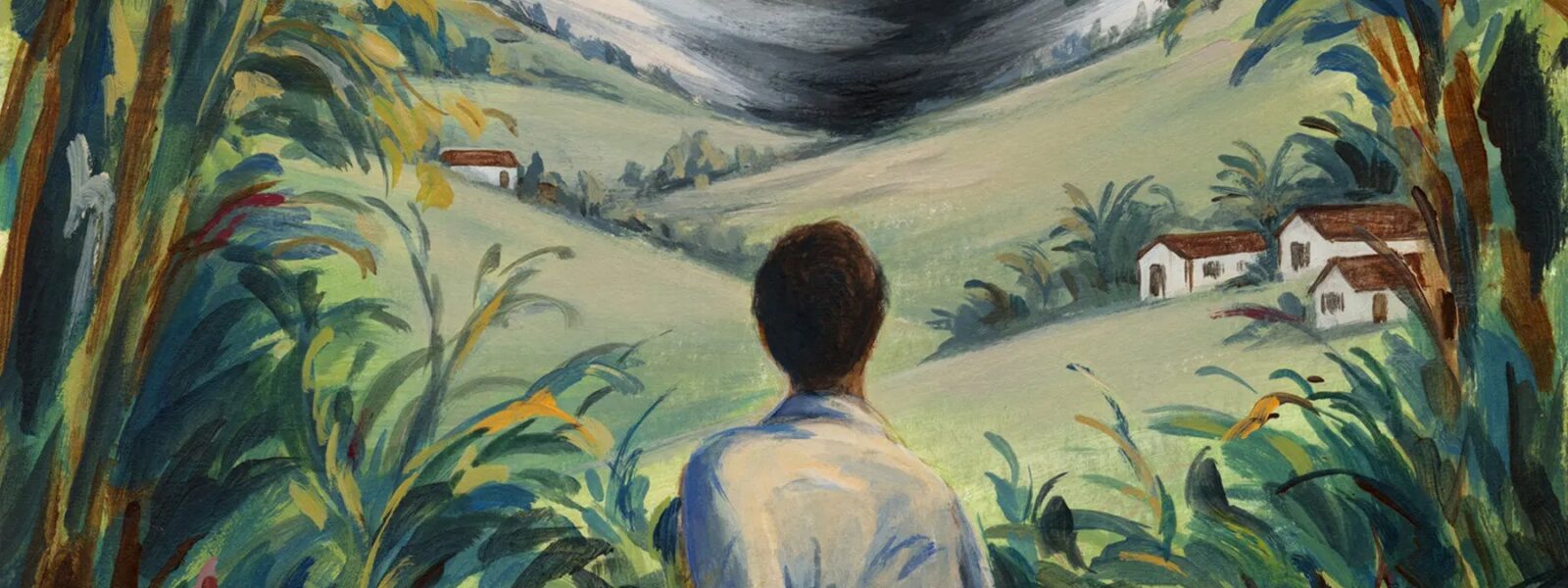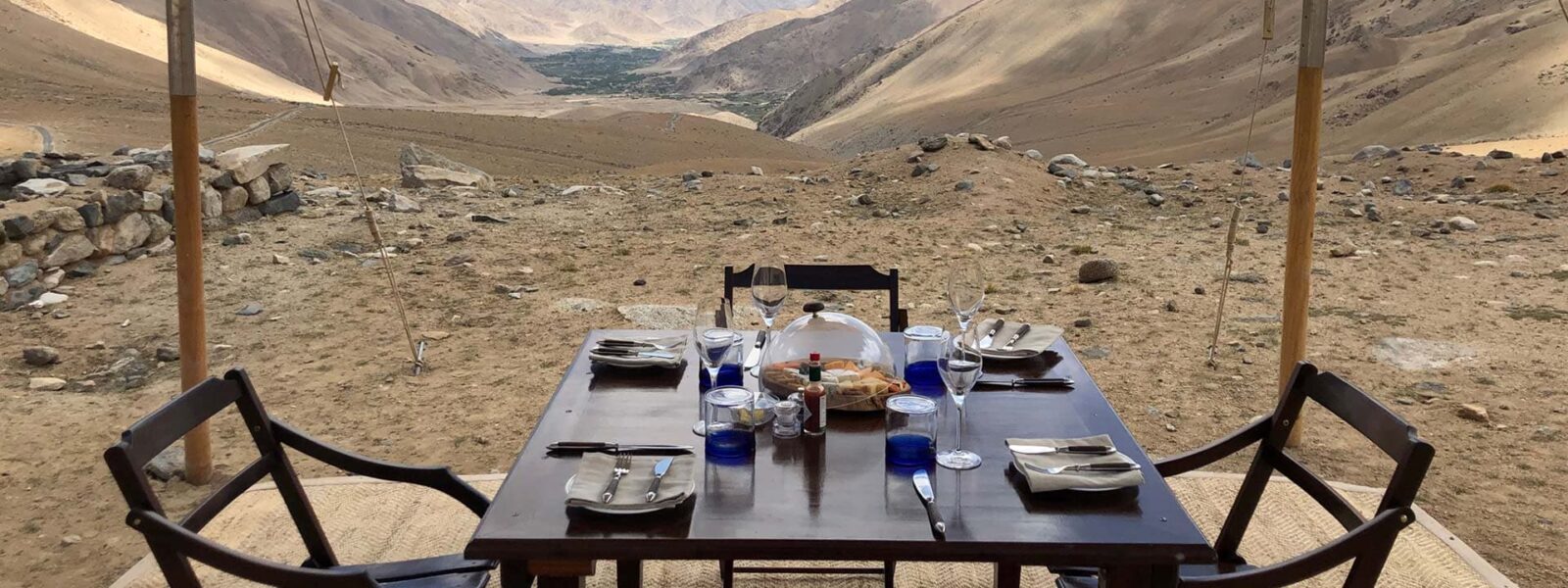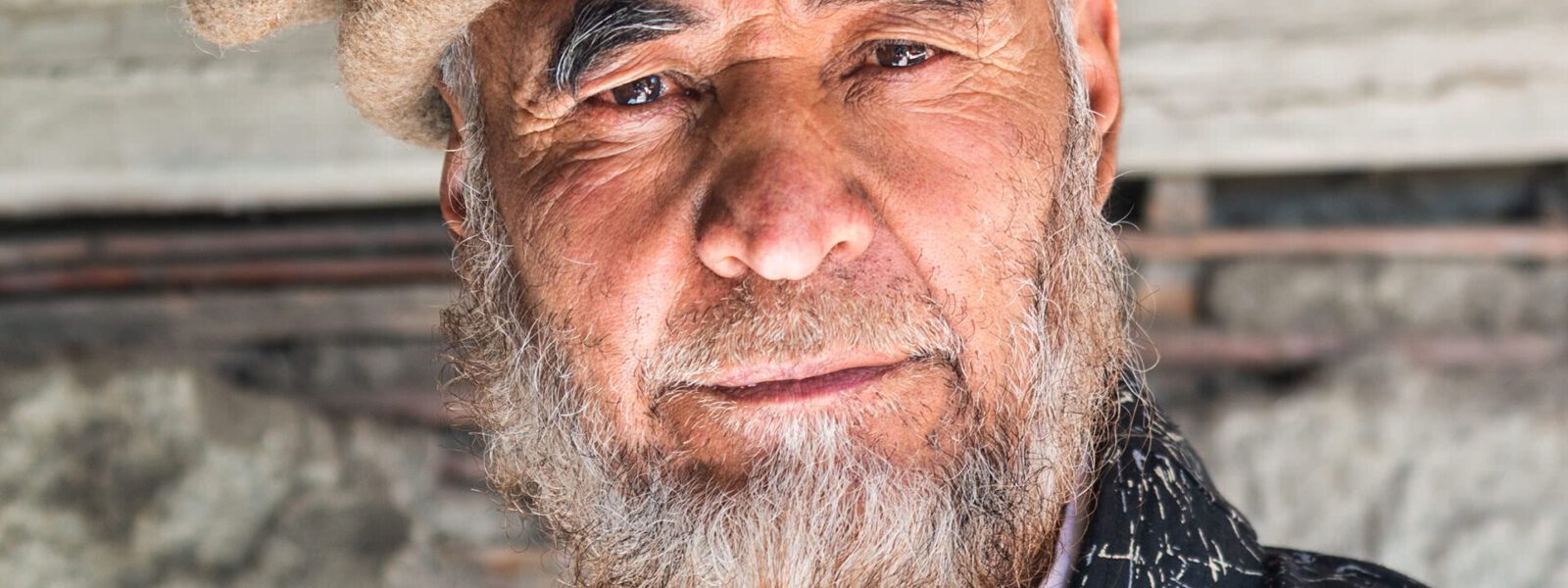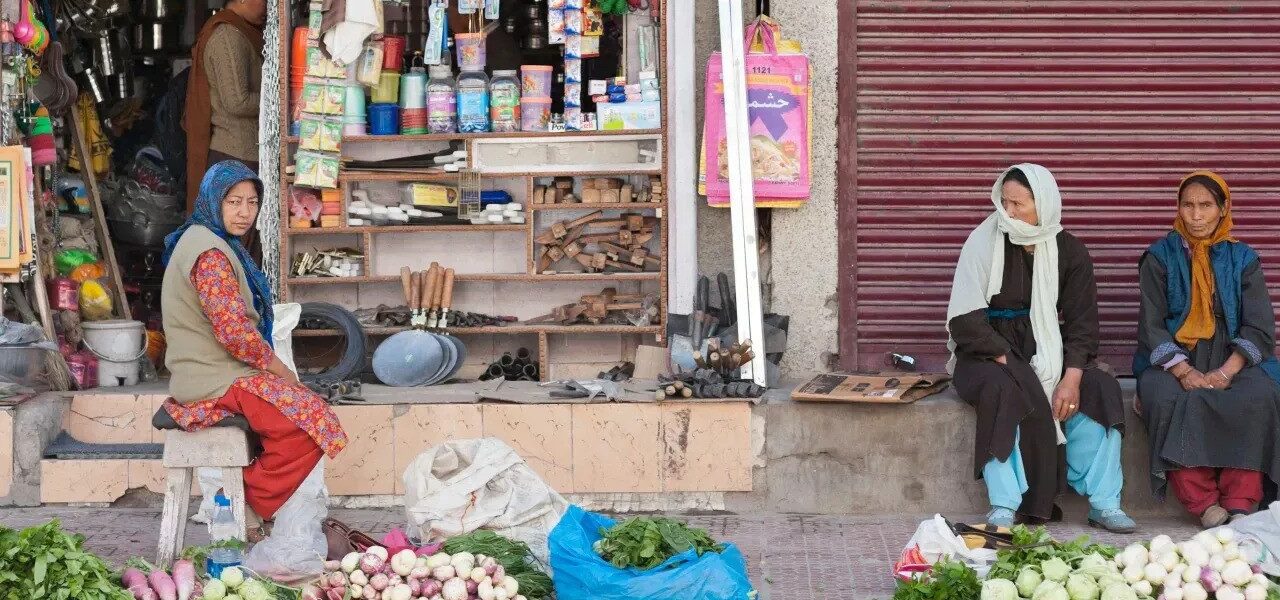Where the Trail Begins: Into the Heart of Zanskar
There is a place where the world narrows into silence, and the mountains speak not with sound, but with wind. In the remote folds of northern India, nestled deep within Ladakh, lies Zanskar – a valley not just forgotten by time, but seemingly untouched by it. It is here, on these ancient herding trails, that every summer a quiet spectacle unfolds: the seasonal migration of goats across the Zanskar Valley, guided by generations of herders who move like ghosts across the high-altitude passes.
To walk with them is to walk into a story that is older than maps, older than borders. There are no roads here, no cafes waiting at the next bend. Only the smell of dry earth, the distant clatter of hooves, and the rhythm of transhumant life—a word that means more than movement. It means knowing the land like family. It means living by its rules.
My journey began in Padum, the administrative heart of Zanskar, but it didn’t take long to feel like the word “administration” had no business being here. The roads are barely passable, the electricity inconsistent. But none of that mattered. I hadn’t come for comfort. I came for connection.
The first herder I met, Sonam, greeted me with a smile that had weathered both wind and winters. His goats—dozens of them, mostly white, some speckled—were already restless. Their hooves kicked at the gravel. The air buzzed with anticipation. This was not just a trek; this was the beginning of a long, age-old ritual: walking with goat herders in the Zanskar Himalayas as they lead their herds from the low valleys to high-altitude summer grazing pastures.
What struck me most wasn’t the grandeur of the mountains, though they rose around us like petrified gods. It was the simplicity. A handwoven bag slung over a shoulder. Butter tea shared at dawn. The quiet understanding between man and animal. And always, the motion. One foot after another. One bell, then another. You become part of the procession before you realize it.
For those who seek more than selfies and summits, this is where the trail begins. You won’t find this journey in mainstream guidebooks. But for the traveler yearning to experience authentic rural tourism in Zanskar, this migration offers a lens into a life both ancient and essential. It’s not just about goats. It’s about harmony with nature, survival, tradition, and the deeply human need to move—not for pleasure, but for purpose.
And so we walked. Into valleys carved by glacial hands. Across rivers still asleep beneath their winter shells. Into a landscape where time drifts slower, but every moment matters. Where the trail begins, indeed, is where you learn to walk all over again—with humility, with patience, and with eyes wide open.

Walking with the Herders: A Day in Motion
The first light of Zanskar is unlike any I’ve ever known. It does not arrive with a jolt, but slowly, like smoke curling up from a distant fire. The goats are the first to stir. Their bells jingle gently, a sound that echoes across the stillness. And so the day begins—not with alarm clocks or city horns, but with movement. Quiet, ancient movement.
By the time the sun brushes the mountain ridges with gold, Sonam and his family are already preparing to move. Their belongings are few—blankets rolled tight, tea leaves tucked away, salt for the goats stored in small cloth pouches. There are no tents to dismantle; just woolen tarps and prayer stones carefully repositioned. Everything is done with intention. Nothing is hurried. This is life on the move in the high Himalayas, and its pace is sacred.
Our feet hit the trail just after sunrise. The herd spills forward like a living river, and we follow. Sometimes I lead. Sometimes I’m lost in the middle. Often, I fall behind—not from fatigue, but because the scenery demands my pause. I look up. A hawk traces the wind. A glacier glints in the distance. The air is thin, but you learn to breathe with your whole body.
We cross narrow footbridges suspended over roaring rivers, their waters fed by unseen ice. We climb slopes where the trail fades into scree, relying on the surefootedness of goats to show the way. At every turn, the landscape feels untouched, uncharted by tourism, and brimming with soul. This is no ordinary trek—it is a pilgrimage of movement, shaped by weather, terrain, and the primal call of grasslands.
Around midday, we pause. The goats scatter into patches of wild herbs. Sonam’s daughter, only ten, prepares tea over a small fire. She watches the herd with a gaze far older than her years. Here, every child learns to read the land before they learn to read books. It’s a school of instinct, and its lessons are etched in stone and sky.
In these hours, you come to understand the rhythm of trekking with nomads in the Zanskar Himalayas. It is not about distance—it is about endurance. Not about conquest—but connection. As an outsider, you are not a guest, but a witness. And as your body adjusts to the motion, your mind softens. The noise of your world quiets. You walk, not to arrive, but to remember how it feels to simply move, to follow, to be.
When the sun tilts westward, the day winds down. A flat stretch of land becomes home. The goats cluster together, the fire is lit, and another day of high-altitude goat migration in Ladakh draws to a close. You feel it in your legs, in your lungs, but also in your heart—a new muscle forming, slow and strong.
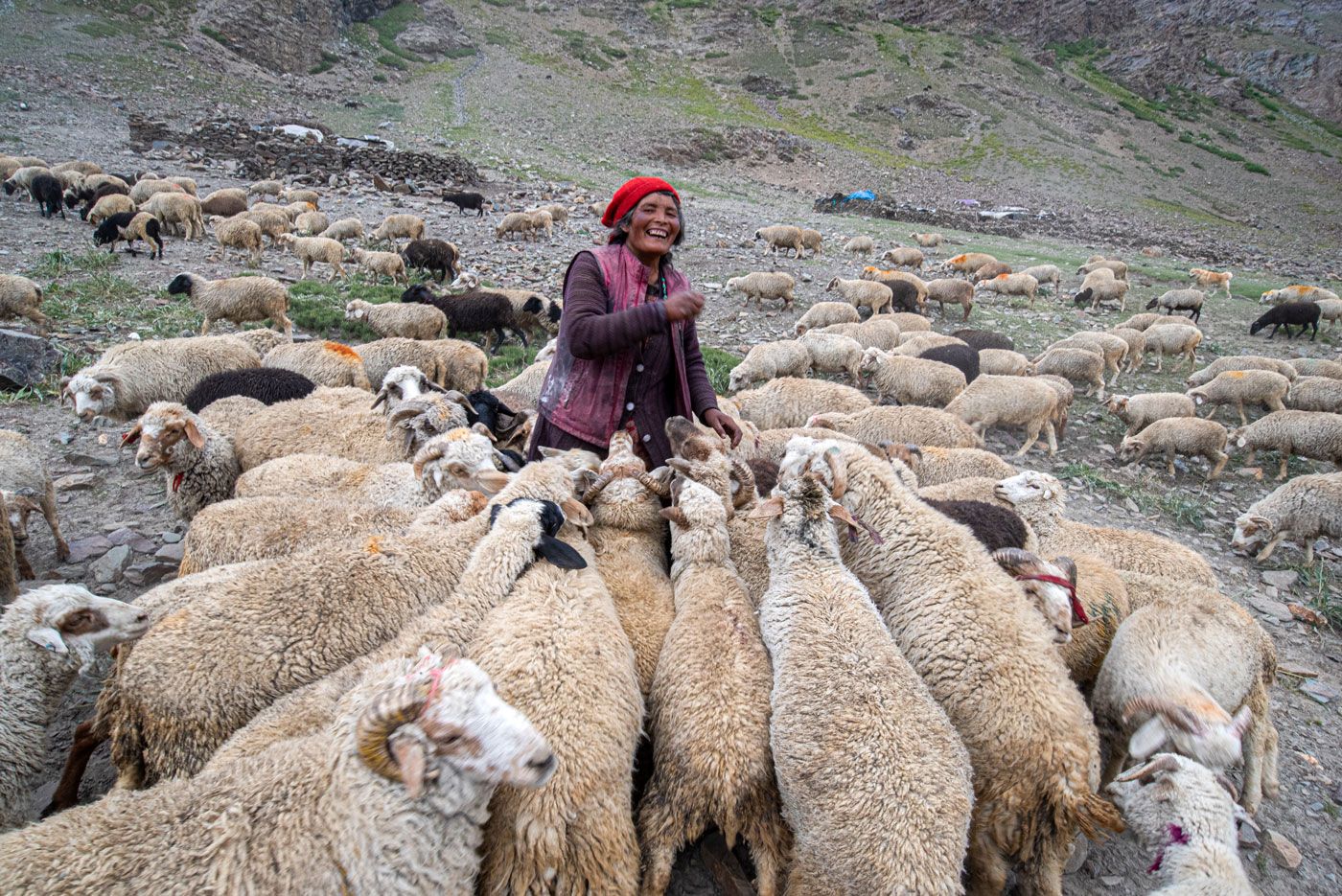
Home on the Move: The Nomadic Life in Zanskar
There is something profoundly humbling about watching a home dismantled and reassembled with nothing more than rope, wool, and memory. In Zanskar, the concept of “home” is not anchored by walls or geography—it is carried on backs, in baskets, and within the hearts of those who live by the rhythm of the land. To walk with the herders is to witness a form of freedom most of us have forgotten: a home that follows the sun, the grass, and the seasons.
Their shelters are made from woven yak wool, stretched and supported by wooden poles that double as walking sticks. At night, they unfurl blankets by the fire. A circle of stones marks the hearth. There’s no electricity, no furniture, no separation between indoors and outdoors. Yet the sense of comfort, of place, is undeniable. The goats cluster nearby, the children play with pebbles, and the adults sit close, sipping butter tea brewed thick and salty.
One evening, as the valley turned gold beneath a collapsing sun, I asked Sonam’s wife how she defined home. She looked at the mountains, then at her daughter chasing a goat with a stick no longer than her arm. She smiled. “Home is where we can see the sky and hear our animals,” she said. That was all. No mortgage, no coordinates. Just sky and sound.
The children of these herding families learn survival before schooling. They know how to track a lost goat by hoofprint. How to tell the time by shadow. How to keep fire alive through wind. While most ten-year-olds in Europe are busy with smartphones, here in Zanskar, a ten-year-old might be entrusted with an entire flock. This is not romanticism—it’s reality. And it is filled with quiet dignity.
The roles within the nomadic family are fluid yet deeply rooted. Women are the quiet power behind the caravan, organizing meals, managing supplies, and tending to the youngest goats with gentle precision. Elders offer stories and spiritual guidance, while the middle generation shoulders the weight of both herd and future. This intergenerational harmony is one of the most striking aspects of life here—each person essential, each task meaningful.
What Westerners may call minimalism, they simply call life. There are no excesses. Everything carried must be useful. Every gesture, deliberate. And in this simplicity lies a kind of wealth—one not measured in currency, but in clarity.
If you are seeking a deeper encounter with Ladakh, beyond the monasteries and mountain passes, consider walking with the herders. It is an invitation not only to move across the land, but to shift something within yourself. To question what “comfort” really means. To redefine “home.” And to carry a piece of that wisdom back with you—not as a souvenir, but as a seed.
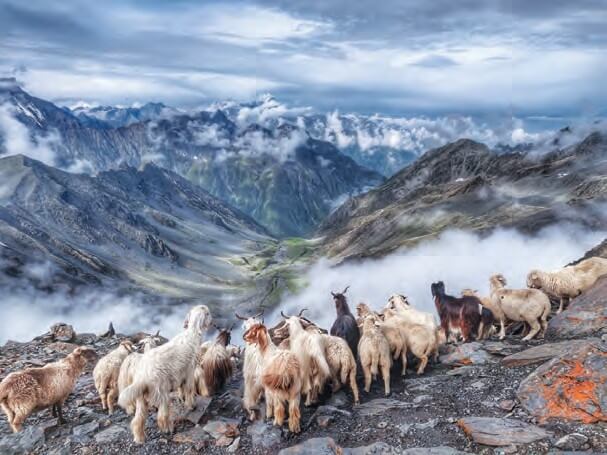
When to Join the Journey: Timing the Goat Migration
The goats don’t check calendars. Their migration begins not with a date, but with the scent of new grass on the wind, with melting ice trickling down slopes, with a whisper from the mountain that it is time. Yet for those of us trying to join this ancient rhythm, knowing when to witness the goat migration in Zanskar can make all the difference between a transformative journey and a missed opportunity.
The seasonal movement of the herders—known as transhumance—typically begins in late May or early June, when the snow has melted enough to reveal narrow, steep trails. This is when the Zanskar Valley begins to awaken after its long winter slumber. The air is still crisp, the rivers swollen with glacial melt, and the high-altitude pastures glisten with life waiting to be grazed.
By July, the herders are deep in the mountains. The journey intensifies as they guide their flocks across mountain passes over 4,500 meters. It’s a physically demanding time, but also when the land is at its most generous—carpets of wildflowers spread across the meadows, and the days are long and luminous. This is arguably the best time for trekkers wishing to experience goat migration in the Himalayas while walking alongside herders in full motion.
Come August, the migration reaches its midpoint. Herders settle temporarily at higher pastures, allowing the goats to feed and regain strength. For travelers, this is a perfect window to witness nomadic life more intimately—when the caravan pauses, and stories are shared around fires beneath a sky exploding with stars. It is during this time that one can feel not like an observer, but a participant in a millennia-old pattern of survival.
By September, the air shifts again. The light becomes thinner, the shadows longer. The goats begin their descent. The return is faster—driven by the instinct to outrun the snow. Early October marks the final chapter of the migration, and by mid-month, the valleys are once again cloaked in silence. Roads begin to close, and winter’s grip tightens.
If you’re planning your visit, I recommend aiming for a window between mid-June and early September. The ideal timing depends on what you seek: if it’s movement and challenge, join at the start. If it’s rest and reflection in the high meadows, come mid-journey. Either way, you will be rewarded—not with landmarks or checklists, but with the rare opportunity to share the road with people who still listen to the earth before making a move.
Remember: this is not a commercial trek. There are no fixed itineraries or guaranteed campsites. To walk with the herders is to surrender to nature’s clock. And in doing so, you may discover a new sense of time altogether—one that’s not ruled by hours, but by sky, season, and hoofbeat.
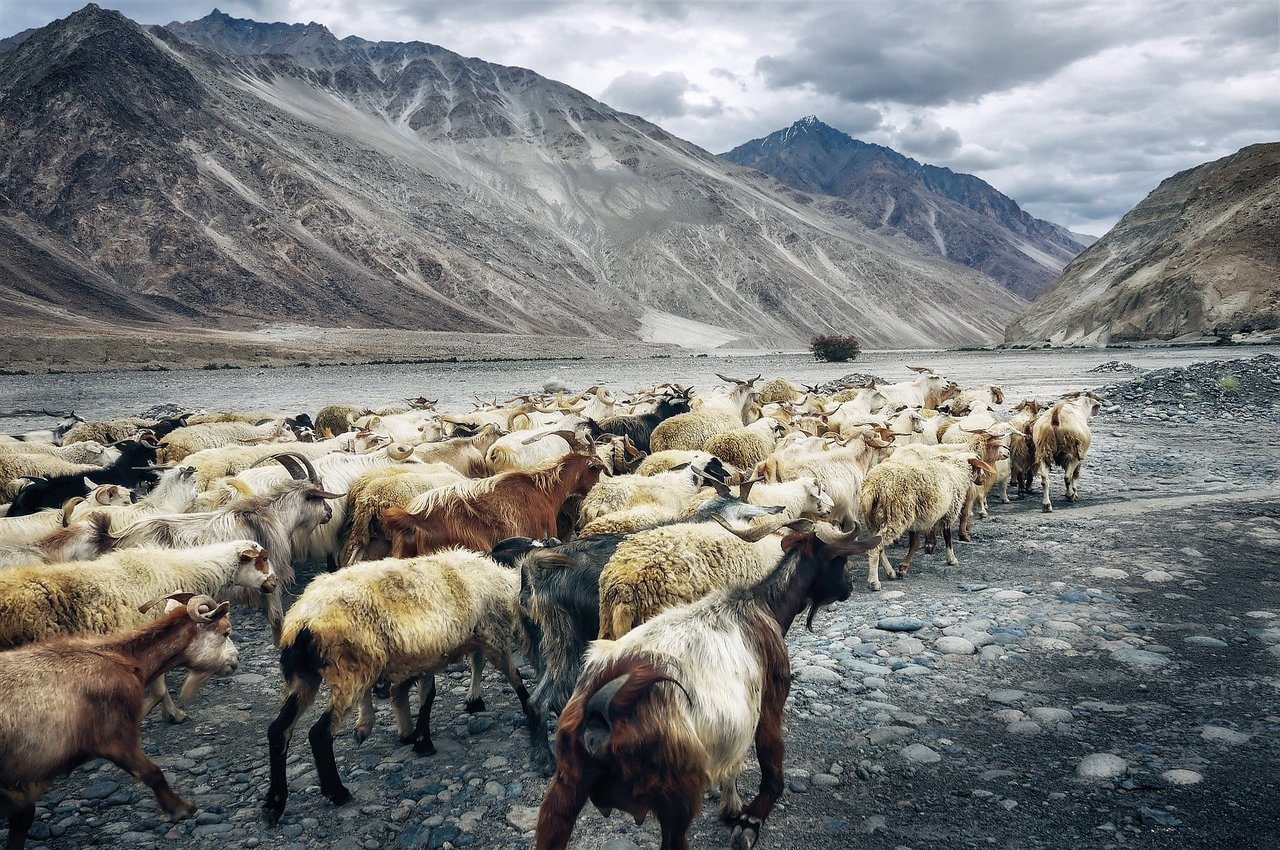
Why This Trek Is Unlike Any Other
There are treks that promise views. Others, adventure. Some offer a fleeting brush with culture. But walking with the goat herders of Zanskar is none of these—and all of them. It is not designed for tourists, nor is it polished for comfort. That’s what makes it extraordinary. This is a journey not to a destination, but into the living fabric of Ladakh’s oldest traditions.
Unlike popular Himalayan treks such as the Markha Valley or the Chadar Trek, this route has no fixed itinerary. There are no teahouses waiting at the next bend, no pre-booked tents or digital check-ins. Instead, there is unpredictability. Rain may shift the trail. A sick goat may delay the group. The herders’ decisions are made in real-time, guided not by apps or maps but by the wind, the clouds, and ancestral memory.
For many European travelers I’ve met on this path—those weary of curated experiences and oversaturated photo spots—this trek offers something rare: authentic immersion. Not the kind sold in brochures, but the kind you feel when you’re sitting by a smoky fire, your clothes crusted with dust, and a child silently hands you a bowl of butter tea. In that moment, you’re no longer a tourist. You are part of the landscape.
What also sets this experience apart is the absence of ego. You are not conquering a peak. You are not ‘doing Zanskar’. You are following. You walk at the pace of the herd, which is to say: slowly, deliberately, and always with purpose. This alone is transformative. For in following, we learn. In slowing down, we notice. And in walking with purpose, not for performance, we return to something elemental.
Perhaps most powerful of all is the sense of continuity. These migrations have happened every year, for centuries. The trail you walk today has been walked by countless feet before yours—hooves, sandals, bare soles hardened by earth. And yet, it’s not frozen in the past. It evolves, breathes, adapts. To walk with the herders is to witness resilience not as a slogan, but as a lifestyle.
For those seeking community-based tourism in Ladakh that truly benefits and engages with local people, this journey is a model. There is no middleman. The money you spend goes directly into hands that live the story you’re stepping into. It’s an ethical exchange of trust, time, and tradition.
So no, this is not an ordinary trek. It is an experience that might not have a trailhead or a summit photo. But what it does offer is far more lasting: a memory that won’t fade, because it becomes part of who you are. And long after your boots are cleaned and packed away, you’ll remember the feel of gravel underfoot, the sound of goat bells, and the warmth of a stranger’s fire shared under Himalayan stars.
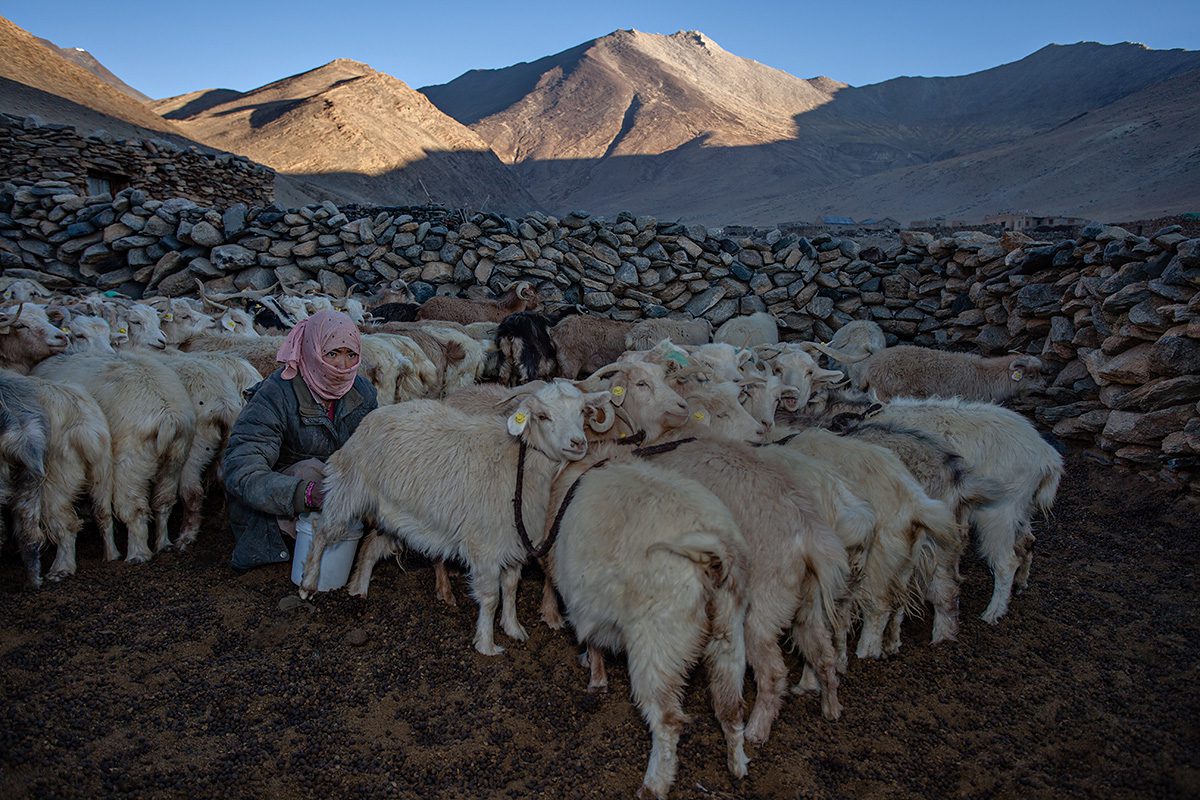
Capturing the Journey: Through a Photographer’s Lens
Some journeys are meant to be lived. Others, captured. But in Zanskar, you do both at once. The rhythm of the migration offers moments of such quiet majesty that even the most seasoned traveler reaches for their camera in reverence. And yet, this is not a place for selfies or quick snaps. It demands patience. It rewards those who wait for the light to change, who notice the angle of a goat’s horn against the sky, who understand that a good photo is less about composition and more about connection.
Photographing the goat migration across the Zanskar Valley is a study in contrasts. The earthy brown of the animals against the glacier-white peaks. The soft curve of a herder’s silhouette beside the jagged outline of a cliff. Dust swirling at golden hour, turning the air into something cinematic. There’s motion, but also stillness. Chaos, but also grace.
One of the most rewarding moments to photograph is just after dawn, when the herd begins to stir. Their breath fogs the crisp mountain air. Bells tinkle softly. The light filters through the silence, and suddenly the world is made of gold and wool. It’s an invitation to document something fragile, something real. Not staged. Not curated. Just truth on four legs.
If you’re carrying a DSLR or mirrorless camera, pack light but bring a versatile zoom lens (24–105mm is ideal). For drone users, please fly responsibly and always ask for consent—some herders see drones as intrusive or disrespectful to their spiritual landscape. And remember: the best photographs are often those you take with your eyes first, long before you reach for a device.
Don’t overlook the faces. There is a universe in the creases of a herder’s smile, in the focused gaze of a child balancing barefoot on a hillside. And the hands—always working, always guiding. These stories are told through wrinkles and rope burns, not captions. Capture them with care.
Above all, photography here is not about taking. It’s about receiving. The Zanskar landscape offers itself slowly, like a story whispered at dusk. You must listen with your lens. When you do, you may leave with images that go far beyond pixels—photos that carry the dust, the breath, the silence of a migration that has walked these mountains for centuries.
So bring your camera, yes. But bring your presence more. For in this part of the Himalayas, it’s not just about what you see—it’s about how deeply you are willing to look.
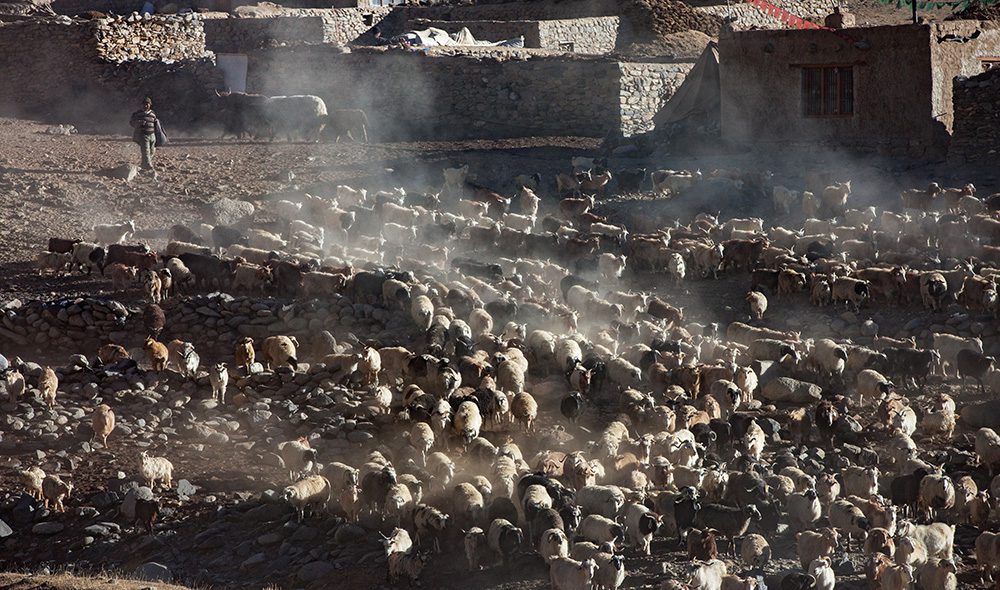
Planning Your Own Journey With the Herds
So, you’ve read this far and you’re wondering: Can I really do this? The answer is yes—but only if you’re willing to travel differently. Walking with the herders of Zanskar is not a packaged experience. It is not listed on standard tour websites or promoted with glossy brochures. It is raw, real, and relational. To join the seasonal goat migration in Ladakh, you need to do more than book—you need to connect.
Start by reaching out to local organizations or guides based in Zanskar or Leh who have relationships with nomadic families. Avoid middlemen offering generic treks. This is a journey best arranged through slow communication and mutual trust. In our case, we were welcomed thanks to a Ladakhi friend who had known Sonam’s family for years. Without that bond, I would never have been invited into the circle of moving lives.
When planning your journey, flexibility is everything. Dates can shift depending on weather, herd health, and pasture readiness. A planned start on June 10 may become June 15. And while this might unsettle the typical European traveler accustomed to structure, it’s part of the beauty: you learn to let go of schedules and start listening to the land.
What should you pack? Think light and functional. A high-quality sleeping bag (rated for cold alpine nights), layered clothing (temperatures fluctuate wildly), sturdy trekking boots, a small solar charger, water purifier tablets, and a respectful attitude. You’ll be off-grid, often without phone signal for days. And you’ll learn that this is a gift, not a problem.
Don’t expect luxury, but do expect richness—of experience, of emotion, of silence. The herders will likely share what they have, but carry your own food supplies (dried fruits, nuts, energy bars) to remain self-sufficient. And always, always ask before taking photos or joining in rituals. Ethical, respectful travel is the only currency that matters out here.
The cost of this journey is modest in money but significant in meaning. You might contribute directly to the family’s needs—goat feed, warm clothing, school supplies for the children. This is community-based tourism in its truest form, where your presence supports not a company, but a way of life.
And when you finally return to Leh, dusty and transformed, you’ll find it hard to slip back into the rush of modern travel. The pace of the goats lingers. The faces of the herders stay with you. And something inside you moves a little slower, a little deeper, as if part of your heart is still somewhere on the trail—walking quietly behind a caravan of life.
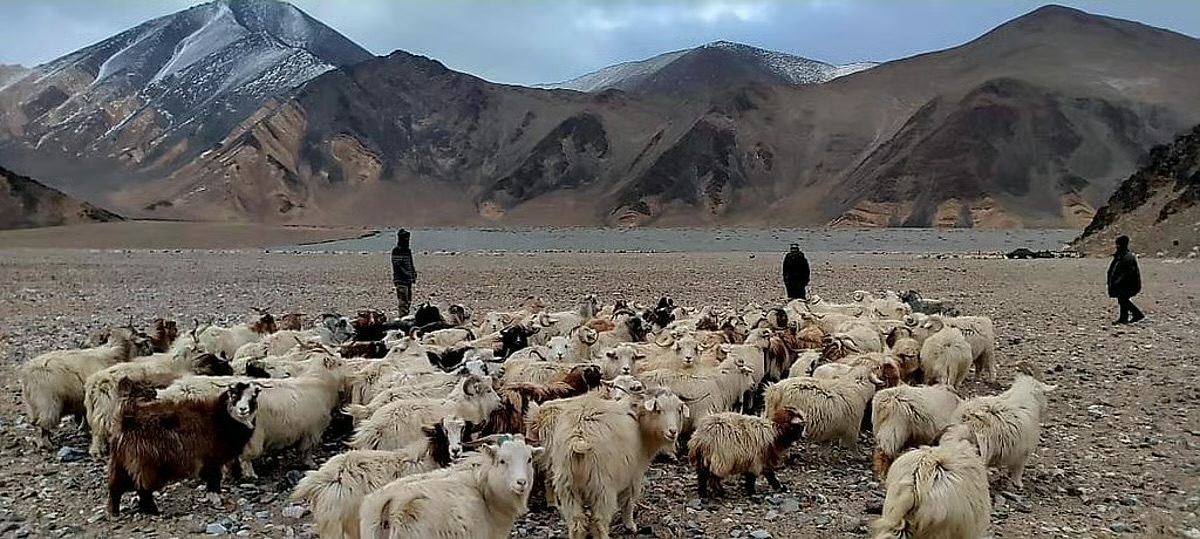
Final Thoughts from the Trail: What the Goats Taught Me
I came to Zanskar expecting a trek. I left with something closer to a truth. Somewhere along the gravelled trails and wind-chiseled ridges, in the echo of goat bells and the hush of dawn, I realized I had not simply observed a migration—I had been part of it. Not just in footsteps, but in spirit.
The goats taught me to walk slowly. Not because of fatigue, but because slowness is a kind of wisdom. They do not rush. They do not resist the rhythm of the earth. They pause when the wind changes. They move when the land allows. In their simplicity, there is clarity—something we, in our over-scheduled, over-stimulated lives, often forget.
The herders taught me something even deeper: how to carry home with me. Not in a bag or passport, but in presence. In patience. In how to light a fire with few tools, how to greet a stranger without words, and how to find contentment in the bare essentials. Their lives are not easy. But they are full. Not of things, but of meaning.
And the land—oh, the land. The Zanskar Valley did not scream its beauty. It whispered it. Through shadows moving across stone, through silence broken only by hoofbeat, through skies that seemed too wide to hold. In its vastness, I found not loneliness, but belonging.
As I re-entered the paved world, with its timetables and notifications, I felt something shift. The migration had left its mark. I walked a little slower. I packed a little lighter. I spoke a little softer. Somewhere deep inside, a bell still rang. And it reminded me that movement, when done with awareness, can become meditation.
So if you find yourself drawn not just to peaks and panoramas, but to stories that breathe, and landscapes that live, come. Not just to trek, but to witness. To walk with those who walk not for pleasure, but for purpose. And perhaps, like me, you’ll return home having learned not just about goats or mountains—but about yourself.
And that, dear reader, is the truest kind of journey there is.
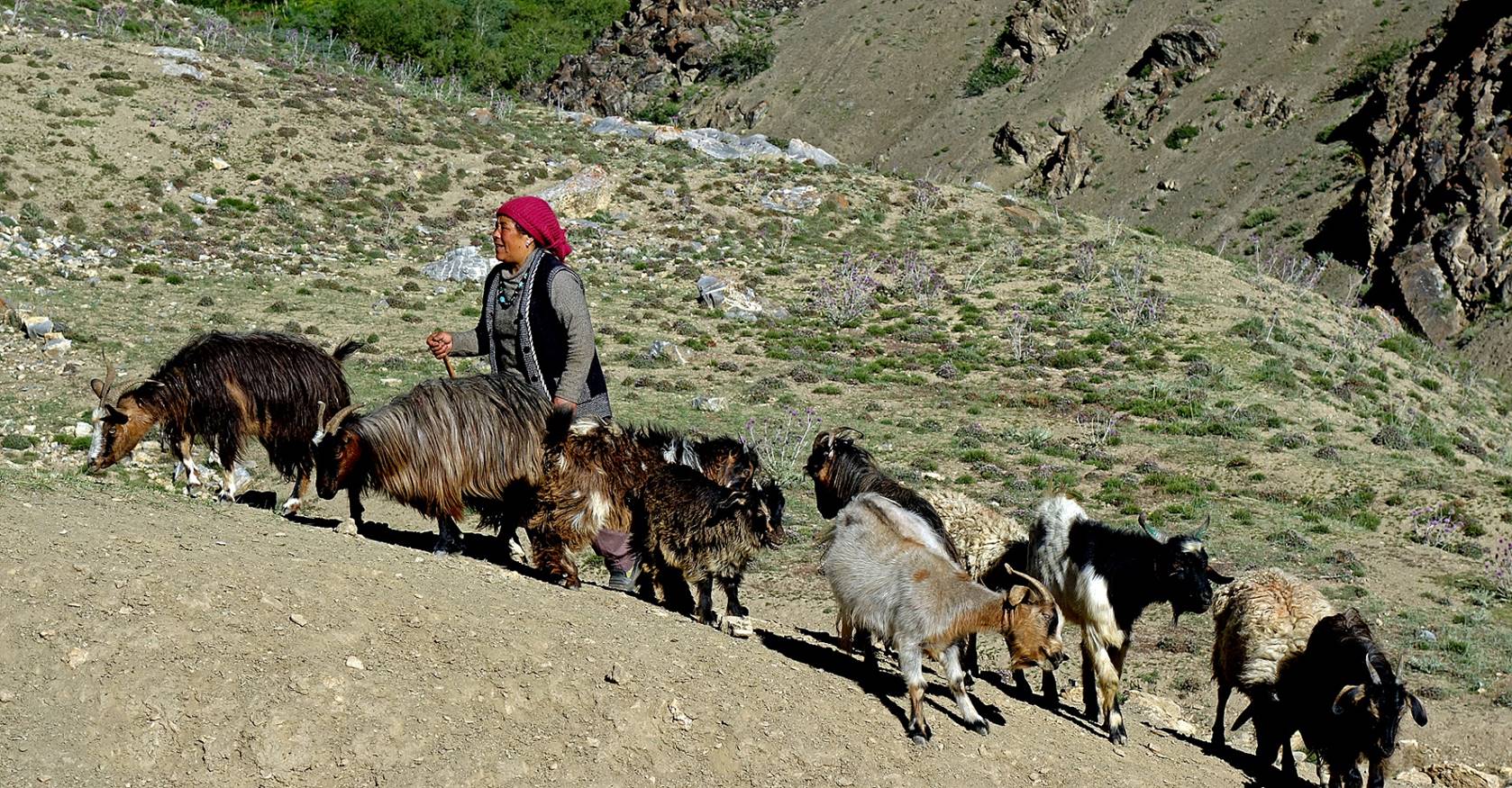
About the Author
Elena Marlowe is an Irish-born writer currently residing in a quiet village near Lake Bled, Slovenia.
Rooted in Celtic storytelling and shaped by the stillness of the Julian Alps, her writing blends poetic observation with immersive cultural travel.
She seeks out paths less taken, often trekking through forgotten landscapes to document the rhythms of local life.
Her columns focus on meaningful, slow journeys—those that challenge not only the body but the way we see the world.
From Icelandic fjords to Himalayan plateaus, Elena writes with the belief that travel is less about ticking boxes and more about deep, human connection.
When she’s not writing, she can be found walking alpine trails with a notebook in her pocket, or sipping strong coffee beside ancient stone churches.
She writes regularly for independent travel publications across Europe.

